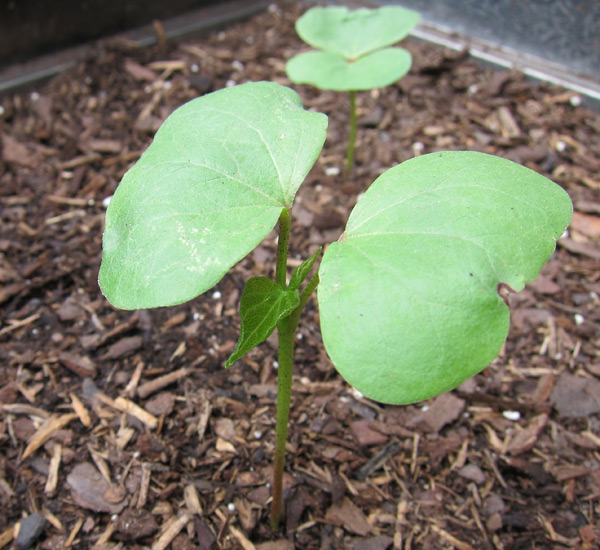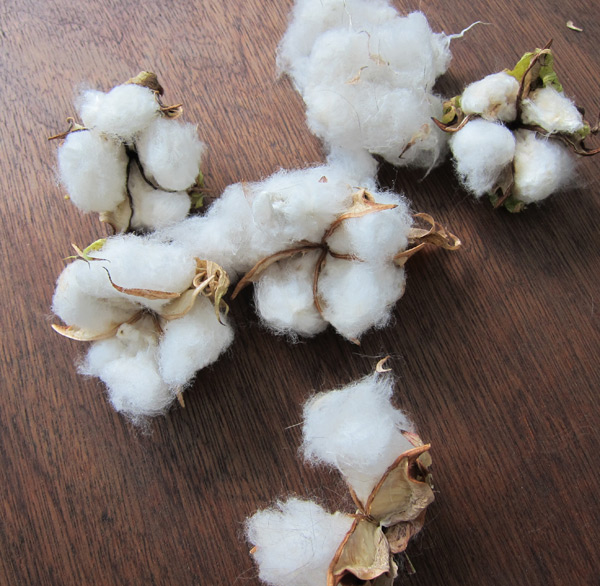Cotton: in the “Wild”
All of the clothing I have made so far, as well as the canvas backpack I recently finished, is made out of 100% cotton fabric. Other than wool and linen, cotton is pretty much the standard for all non-athletic menswear, and yet I found myself wondering, how many people (including myself) give any thought to where cotton actually comes from.
The raw materials that go into those neatly stacked bolts of fabric in a fabric store, or the perfectly folded shirts in a retail clothing shop have undergone so much change and processing that they barely resemble their original form. We can’t exactly wear raw cotton fibers, so this processing is necessary, but how many times have you thought of that spread collar, oxford cloth, button-down shirt as a something that started out as a plant?
I decided that I want to know more about where the shirt on my back comes from, or at least learn a little about the plant from which my clothing is derived. So, this past summer I did a little gardening experiment and grew some cotton on my porch.
It’s hard to believe that so much of our clothing starts out as these little seeds.

Little baby cotton plants.

When the cotton plant blooms, it has these gorgeous, delicate, yellow flowers that only stick around for a day or two. They quickly turn a light purple color and fall off. From here the cotton bolls start to form.

After a week or two, the bolls begin to open up and you can see the cotton fibers inside.

Once the cotton bolls fully opened and dried out, I removed them from the plant.

There is an old cotton mill about 100 yards from where I live, but unfortunately it is no longer in use. I would love to go see the next step in the fabric production process, where cotton bolls like these ones are turned into something that resembles the fabric we have come to love and depend on.



What a neat experiment.
Did the cotton flowers have any scent? (I was surprised by how lovely yours is.)
Are individual fibers strong (or big) enough for you to separate one out on its own?
How long do you think the fibers are?
Have you played with fibers at all and tried to roll out a bit of yarn on your own?
“Places in the Heart” showed cotton pickers with bloody fingers from picking bolls for days. Based on your bolls, does it seem plausible?
Sort of tangentially, I’ve been wondering about cotton for ages. I’ve read that it’s one of the few fibers that is stronger when wet than dry and I’ve been wondering how that works. And what’s the cotton for from the plant’s perspective? Does it protect the seed or aid in dispersal or what? I suppose I could google these questions. Anyways, thanks for sharing; supercool.
I don’t recall the flowers having much of a scent. While I haven’t played around too much with individual fibers, the bolls themselves are rough and sharp in places. I can definitely see how they would tear up your hands if you were picking lots of them.
Fibers can be separated out, and most of them are about 1″ – 1.5″ long (2cm – 4cm)
The seeds are down inside the cotton fibers and I believe this helps to disperse the seeds once the bolls open.
Taylor,
As someone who’s followed your site and ordered denim from you a couple of times in the past, I think it’s really an interesting process learning how to make one’s own clothing. I know it has been for me, and from what I see from your blog, it has been for you too.
I think it’s really cool that you grew some cotton plants from seeds to see where the fiber we all take for granted comes from. But there’s such a dark side to cotton too. Not only was cotton responsible for slavery in this country, but cotton is the most toxic crop grown in the world today, due to it’s abundant usage of fertilizers, pesticides and defoliants. Not to mention all the energy, water and chemicals consumed in growing, processing, dying and garment manufacture that goes into cotton. 900 gallons of water is used for one pair of blue jeans and 1,083 gallons of water for a cotton shirt. There’s an environmental price for everything we consume and manufacture.
I know you have posted on consumerism and where our garments come from and at what price. I applaud your efforts and so look forward to your future endeavors.
Regards,
John
Hi John,
You are absolutely right. There is a dark side to cotton (as well as a lot of things we buy and use). This post completely skips over the negative aspects of commercial cotton growing as well as the history involving slavery in the US.
I don’t know enough about synthetic fibers to know if there are any viable alternatives to cotton. Being that many synthetics are derived from petroleum and sprayed with things like formaldehyde and other chemicals, natural fibers seem like the lesser of two evils. The key is to produce them in a sustainable way that is less reliant on fertilizers and other resources. Organizations like this one: http://www.sustainablecotton.org offer some encouragement.
Taylor,
I can’t see any synthetic being any improvement over cotton. Besides, synthetics will be around in the landfills for a really long time. As far as formaldehyde goes, I was told that all imported fabrics are sprayed with formaldehyde to control pests, so it can be imported into this country.
There is an article in this week’s Bloomberg Report about Levis and Cone Denim creating a denim fabric with 20% recycled plastic (pet) bottles. The Levis spokesperson states that cotton is the single most volatile commodity in the apparel industry. If they can replace 20% of their fabric content with a reliable source of material they’re going to do it.
Personally, I try to use plant based fabrics in the things I sew; organic cotton, linen, I’m also starting to use hemp fabric from: http://www.hemptraders.com. Hemp is a lot stronger than cotton and it really softens up when washed. Think linen. I try to use cotton or linen thread too. Although mercerized cotton is whole other chemical treatment.
I do like Cone Denim because it’s top quality, the selvedge, and that it’s made here. What I don’t like is all the dye though. Even after washing any blue jean denim first my hands and sewing machine are blue working with it. Not to mention my wallet, belt, and tops of my shoes from wearing it.
In the end, I think we just need to be more conscious about what we consume. Making clothes myself has really been an education for me. All the steps and processes that go into putting together a garment is fascinating to me.
On another note, I just bought a used industrial Juki sewing machine and loving it. You’re right, industrial machines do one thing, but they do it very well.
John,
I agree, learning to make clothing is definitely educational in more ways than one. Congratulations on your Juki purchase! I rarely sew on a domestic machine now that I’ve gotten used to the industrial. Thanks for the link to Hemp Traders. If you have any other sources for organic/sustainable fabric options I’d love to know.
Taylor-
Taylor,
I would definitely get Hemp Trader’s swatch book of all their hemp fabrics. I think it’s $20. Definitely worth it to see the actual fabric. They also sell hemp webbing too.
A couple of sources I can think of are:
http://www.naturesfabrics.com has organic cotton, bamboo, wool, and hemp fabrics.
http://www.nearseanaturals.com has organic cotton, wool fabrics, and organic thread.
-John
http://www.newenglandsimpleliving.com/spinningcottonhandspindle.htm Hand spun cotton. I have a crocheted mat from my great grandma. She grew the cotton, carded and spun it, and then made the decoration. She did it for a hobby and had never farmed cotton. Have you looked into the processing of cotton for textiles? Is it a fairly green process these days?
The institute where I did my PhD has a lot of agricultural research and we used to have someone working in cotton. The last I heard Levis was looking into GM blue cotton (because the dyeing process is so wasteful and environmentally toxic). Cotton is actually one of the few plants I’d actually support (well planned, seriously well though out) GM modifications for – it’s one of the most environmentally degradative crops (apart from sugar cane and to some extent corn) in terms of pesticide use, chemical fertilizer use and excessive irrigation requirements not to mention its adverse effects on increased soil salinity .. that being said I prefer natural fibres to everything.. Linen and flax are both good but ugh the wrinkles..
Hemp and Flax provide a fantastic alternative to cotton, and both materials are stronger and more breathable than cotton. In their production they use far fewer pesticides or fertilisers than cotton. Linen and hemp are one of the few fibres to get stronger when wet meaning they stand up to washing and heavy use far better. The first pair of Levi jeans were made from hemp.
Also as most flax linen production is centred in the EU, especially weaving its an ethical product as well.
Very cool. I’d be interested in seeing more of the process of turning raw cotton fiber into soft fabric. I would also be interested to see how hemp compares with cotton in this department, whether it is easier or more cost effective and what not.
Much fun! I tried growing cotton this past year and the learning curve was a roller coaster ride. However, I tried to grow naturally colored cotton. I’ve reordered seeds and am anxiously watching the calendar. My challenge is that I live in Colorado and can definitely attest that our growing season is not the same as yours. I was able to harvest some brown fiber. Yes, I ginned it by hand and am waiting for my cards to come so I can begin to spin it. There is also a blend of cotton and alpaca that is heavenly to spin. Talk about natural…
My friend recently sent me some fresh grown cotton seeds for me to plant. They are just beginning to sprout up in the dirt. I’m so excited to watch them grow. Hope to keep on planting them so I can have more plants.